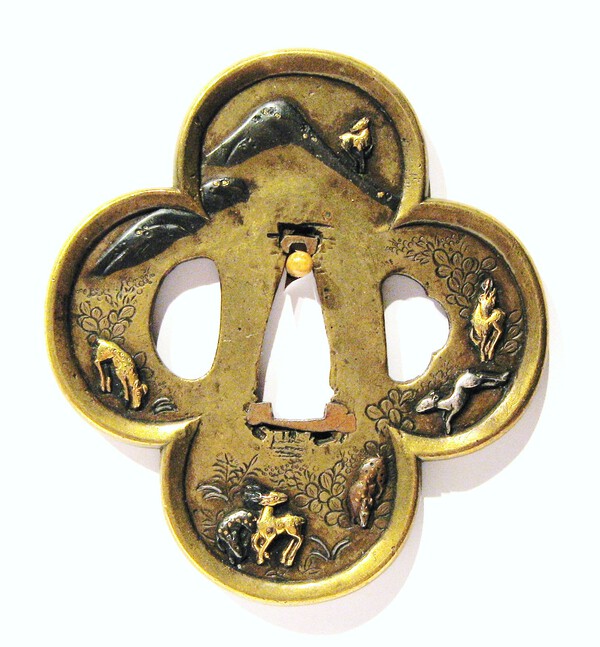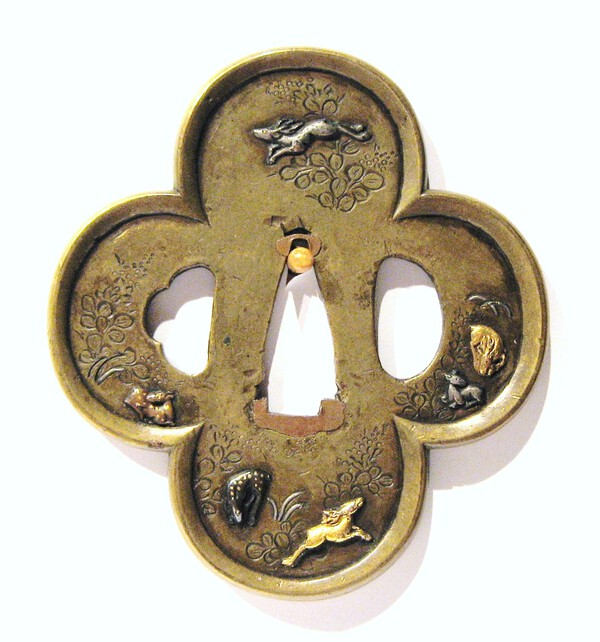
elliottshogun
Members-
Posts
45 -
Joined
-
Last visited
Content Type
Profiles
Forums
Events
Store
Downloads
Gallery
Everything posted by elliottshogun
-
Everyone, Robert and I thank you for your comments and remarks. We have discussed your thoughts, ideas, and concerns and will leave it at this ----- the date is approx. 1500. Being a 'Court Nobility' tsuba, it was produced by a combined effort between a metal caster (unknown who or which group) of which there were many at this time, and an early Goto artist (unknown which one) who were the only ones doing extremely fine carving, and inlaying/onlaying during this time (ca.1500). The 'legend' depicted is in the "Legend in Japanese Art" by Henri Joly about the deer looking for their mates who are among the clover. I have never seen this depiction on any Japanese artwork, but thats just me. If we happen upon any new information in regards to this tsuba, I will certainly post it here. Thank you all very much. Elliott
-
Gentlemen, First I must apologize for confusing the 1500 date with Momoyama period. I meant the Muromachi period. All of your comments have been noted and thru comparison to other tsuba's (including Tachi and nobility tsuba) made by metal casters, we are keeping the ca.1500 time frame. We have discovered that this particular piece was a combined effort between the metal casters and an early unknown Goto artist(s). The metal casters did the plate and rim, the unknown Goto artist did the inlay, carving and design motif. Which Goto school or artist is unknown. But comparison of Goto kozuka and kogai pieces with like designs of animals, landscapes, etc. seem to confirm the detail given to this tsuba. This design motif is rare, and I would ask if anyone has seen any Japanese metal object or artwork with this subject? There may also, be a legend being told here but I have yet to discover it. Elliott
-
Sorry to have been away........in response to your comments: This tsuba (along with the other three) were purchased by Robert Haynes. This particular one is being studied by Robert and was put forth to obtain thoughts on what school and/or maker. The date of 1500 was determined by the overall appearance of this piece, the 'crud' factor of the hitsu-ana's and nakago-ana, and from years of handling (and studying) 1000's of tsuba. Determining the age of a tsuba is the first thing one does. This leads to then determining the artist. Determining the artist is the BIG question. I have been struggling with this and am leaning towards metal artists of the Muromachi/Momoyama periods. Those tachi fittings made for Court Nobility are of consideration, but who or what school is the question. Robert made a comment to me stating that this is the finest soft metal tsuba he has ever seen. Keep the comments coming............. Elliott
-
I appreciate the reply's. Based on the date (ca.1500), I am leaning towards the brass casters of the Momoyama period. The Nara school came along 150 years later and this piece would be something the Nara school might have used as a model for their work. Keep the comments coming.............. Elliott
-
Hello everyone, I have attached images of a tsuba that is very puzzleing to me. It is wonderful to hold and study but there are no hints for me to consider what school it came from. Brass plate in mokko shape, large brass rim attached. Ca.1500. The mountains are in shakudo, the thirteen deer (7 on front, 6 on reverse) are done in copper, gold, silver, and shakudo. Size is 8.5cm x 7.7cm. Any suggestions will be greatly appreciated. Elliott
-
The search will continue with hopes of finding this book. I found the following reference (from a very sure source), with a different published date: Sasano Masayuki: Akasaka Tsuba, 18.5x26, 44p, Tôken Kodôgu Ten, Tôkyô, 1966 The publish date is a help, I now have two for reference. Thank you all for your help, the search goes on.................... Elliott
-
I should add something further................ the Japanese Sword Touken Komachi art_books web site shows this book with the author being Hiroyuki Sasano. (If you go to 'katana books' and scroll about half way down, you will see the book.) You will also note that the two books 'SUKASHI TSUBA' & SUKASHI TSUBA BUSHIDO no BI are by the same author, Hiroyuki Sasano. We all know that the last two books were authored by MASAYUKI Sasano, not HIROYUKI Sasano. Maybe they are reading the kanji wrong, I don't know. If someone has the 'AKASAKA TSUBA' book, I would sure like to hear from them. Thanks, Elliott
-
Jean, You have no idea what I have attempted or tried to find this book and its author. Thought I might give a 'shout' to the members of the Nihonto Message Board to learn if anyone knows of either the book or the author. Certainly don't need a 'caustic' remark about a search button - "Did you even try to hit the search button at the top of the page?" No help from the search button. Elliott
-
Hello everybody, I have a question about a book and the author............... The book title is 'AKASAKA TSUBA' by Hiroyuki Sasano. The publisher is Touken Kodougu, Ryouhei Yamaguchi, published in 1977. Who is Hiroyuki Sasano? Does anybody own this book? Is there any relationship between Hiroyuki and Masayuki Sasano? Could this be an incorrect translation of Masayuki? If anyone has this book, can you send me an image of the page that displays the author, publisher, cost, date, etc. This is not the AKASAKA TSUBA book by the Sano Museum. Thank you, Elliott
-
All, The last rounds of discussion about Namban (et al) being cast or not is not important to me. What is important (to me) is the 'aesthetic' quality of any school of tsuba. I study and purchase those tsuba that I buy with my 'heart'. Admittedly, I have purchased and studied many Namban tsuba. I have read 3 or 4 times, Dr. John Lissenden's book and will no doubt read it again. What Dr. Torigoye wrote about the three types/classes of Namban tsuba I concur with and use this as a basis for determining the style of those that I own. I have one Namban papered by the NBTHK that is not signed. I also have a Namban made in Hizen, with European influence and it is forged, not cast. All that Bob Haynes and I did with my Namban tsuba was confirm which style of tsuba each was: Namban, Kanton or Kagonami. Elliott
-
David et al, I haven't recovered from the fabulous SF Token Kai. Just the thought of having unlimited access to Robert Haynes kept me busy for three days. We discussed every tsuba that I brought to the show. As soon as I gather my thoughts, I will pass on any info about Namban (Kanton, Kagonami) tsuba that I have even though the conversations pertained more to the amount of work that goes into each piece (there are exceptions). Casting was not the main topic of conversation. More later.............. Elliott
-
David, I contacted Bob and told him I was bringing all my Namban tsuba to SF and that we could talk about each one. I have re-read the 'Tsuba, An Aesthetic Study' and Dr. John's 'Reappraisal of Namban Sword Guards'. Now, I am re-writing (on my web site) some info that I put in incorrectly. The 'cast' part is still an area for continued study, it was certainly used in the late Edo for the mass production pieces. I may look into attending the Florida show. I will stay in touch. Elliott
-
To both David's, I just compared my (in hand) Kannan (Namban) to the images sent by David and they are NOT identical. The seigaiha diaper patterns are different, the ana's are of different design (very small ingraved spots) and my seppa dai show signs of being mounted (wear on the diaper pattern). I am still in agreement that mine may be cast. Elliott
-
To 'All' who are involved in this discussion: How many of you are attending the SF Token Kai? I will certainly bring my Namban Tsuba, especially those (3) which very possibly are considered cast. My invitation is for you to stop by my table and further discuss casting. I will also contact Dr. John Lissenden in the UK and get some added input from him. WOW! What a boost to my education. Elliott
-
David, You are correct, I was in error and am correcting this today. I have three Namban that are late Edo pieces and are possible copies of an original because I have seen duplicates everywhere. And I will update my website info with the appropriate corrections....... all part of the learning process. Elliott
-
Some time ago, I asked a question about 'cast tsuba' to which Dr. John Lissenden (sp) (who wrote the book on Namban tsuba) educated me on this subject. I had a signed 'Masahisa' tsuba that was cast and was the subject of my initial questions to the Nihonto Study Group. I am continously studying Namban style tsuba with the help of my Sensei Robert Haynes. To date, I don't believe any of my Namban tsuba are cast. This belief may change over time. I really don't consider myself a 'vendor', more of a student/collector. We all have our own opinions. Elliott
-
Not only 'nihontocraft' but Richard Stein's site as well as mine defines the columns as to what they mean. I copy (xerox) my paper then break out the books (neilson, etc.) and spend a day translating the kanji. It helps to have your 'yellow' slip with you. And this teaches you different kanji which at my age lasts about a day....... Elliott
-
For those who are waiting for papers, I received mine today (12/21/2010). What a great gift! Elliott
-
At SF Token Kai, after your submission it was about 3 hours and you then knew whether you were receiving a 'pink' or 'yellow' slip of paper. Elliott
-
Thanks Mark, I will 'kick-back' with my 'B&B' and wait them out. Elliott
-
Just curious, how long does it take to receive paper by the NTHK? Had two tsuba papered at SF Token Kai and am anxcious to receive the appraisals. Thanks. Elliott
-
I apologize, I meant to address that last post (from me) to all of you: Ron, Tony, and Peter. Your reflections are wonderful, keep them coming............... Elliott
-
Peter, If I am allowed to use these pictures, I will expand both my Tameshigiri page and link to his origami that I have. This will contain a small Bio about Kotoken. Elliott
-
Thank you Ron, I am using the origami I have as my example. Ron Hartmann is sending me pic's of a Toen Sha? and one other for my use. I did find a web site displaying a few other Japanese origami that I have never seen before. As soon as I can connect with them, I will inquire about these unknown papers. Thanks again for your help. Elliott
-
Thank you Tony & Tom, I will put this news to work and immediately search for that book. If you have any interest in what I have done with origami, check out my sword gallery http://www.shibuiswords.com/gallery.htm . I am adding a copy of the Toen paper and one other soon, and I will add the picture that I just saved. Thanks again, Elliott


